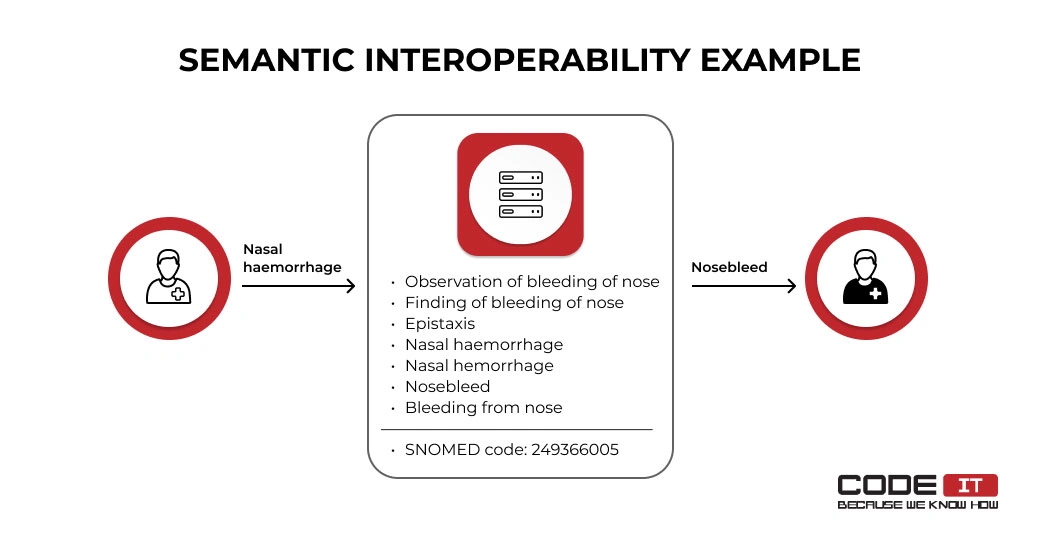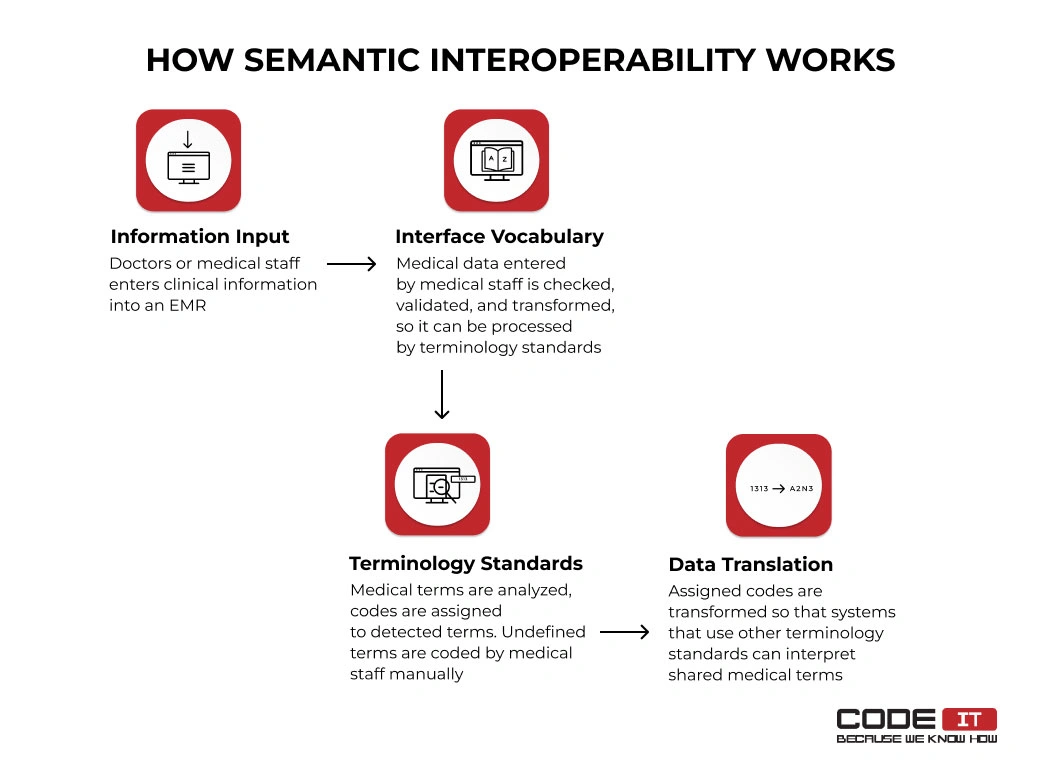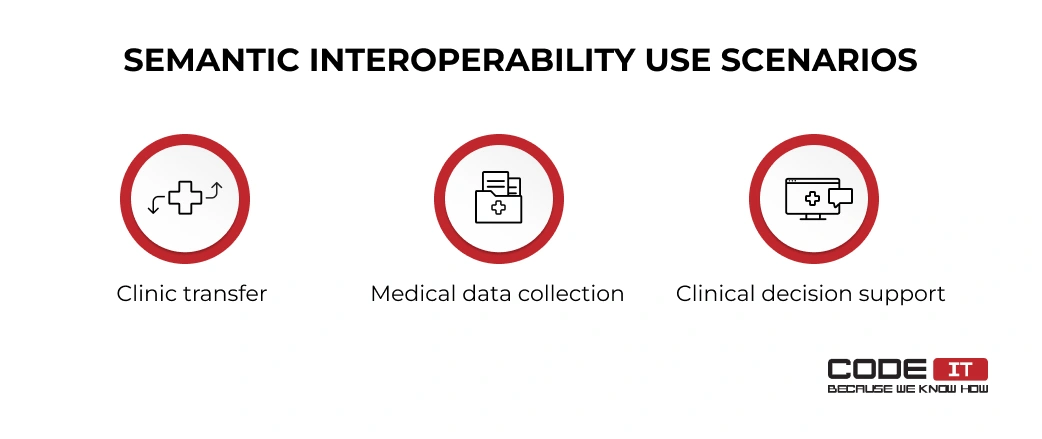Semantic Interoperability in Healthcare


The alternative names for “attention deficit hyperactivity disorder” are “ADHD”, “hyperkinetic disorder”, and “hyperactivity syndrome”.
“Falling sickness” is an outdated medical term for “epilepsy”, and “fracture” is a medical slang term that defines a “broken bone”. Moreover, the “hemorrhage” and “haemorrhage” medical terms are spelled differently but have the same meaning, defining bleeding.
The adoption of semantic interoperability in healthcare helps medical organizations avoid misunderstanding when describing the same diseases, diagnoses, or clinical cases using different words.
What is semantic interoperability?
Semantic interoperability in healthcare defines the opportunity of different systems to exchange and interpret data, keeping its unambiguous meaning. It enables electronic health record (EHR) systems from different vendors to interchange medical data, avoiding misapprehension.
- Foundational interoperability layer refers to the ability of different systems to exchange data error- and loss-free. The foundational interoperability level describes the physical communication of systems using networks or point-to-point connections.
- Structural interoperability layer needs medical organizations to compose data following defined rules and transform it so that systems that use different technologies can interpret received information. Health Level Seven International (HL7) interoperability standards are the most commonly applied on this level.
- Semantic interoperability layer enables doctors and medical staff to interpret the shared meaning of medical terms, symptoms, and diagnoses to avoid misunderstanding.
Need perfect-fit software solution?

Business First
Code Next
Let’s talk
Semantic interoperability represents the third layer of intercommunication. It can be described by the usage of standardized messages, clinical vocabularies, and codes.
Check out the simplified example of semantic interoperability in healthcare below.

Let’s take a deeper dive into the semantic interoperability challenges experienced by medical organizations.
Problem semantic interoperability helps solve
There is a vast assortment of EHR systems from disparate vendors available. They facilitate patient care and help improve the daily workflow of medical staff.
Unfortunately, doctors may use disparate terms to describe the same diseases, diagnoses, and clinical cases, which is one of the core problems with semantic interoperability in healthcare.
Moreover, many medical terms and diagnoses may have dissimilar names, including slang or abbreviations.
Check out the variety of synonyms describing the same symptoms.
| Widespread Symptom Name | Alternative Symptom Names |
|---|---|
| Pneumonia | Pulmonary infection, Lung inflammation |
| Alzheimer’s disease | Alzheimer’s dementia, Presenile dementia |
| Hypertension | High blood pressure |
| Myocardial infarction | Heart attack, Acute myocardial infarction, Cardiac infarction |
| Asthma | Reactive airway disease, Bronchoconstriction |
| Osteoarthritis | Degenerative joint disease, Degenerative arthritis, Wear-and-tear arthritis |
Disease names change over time. However, some doctors and medical staff may use outdated names, including the following.
| Outdated Medical Term | Present-Day Medical Term |
|---|---|
| Ablepsy | Blindness |
| Congestive fever | Malaria |
| Domestic malady | Depression |
| French pox | Syphilis |
| Grippe | Flu |
| Swine flu | H1N1 virus |
| The shakes | Parkinson’s disease |
Many abbreviations and acronyms are used by doctors to simplify their daily operations. Here are some of them.
| Abbreviation | Full Term Name |
|---|---|
| BMI | Body mass index |
| CHF | Congestive heart failure |
| ECG | Electrocardiogram |
| EMS | Emergency medical services |
| Rx | Prescription |
Doctors may use informal terms known as medical slang.
| Medical Slang | Formal Medical Terms |
|---|---|
| Appy | A patient with appendicitis |
| OD’d | Overdosed |
| Stat | Immediately |
| Thready | Weak pulse |
| Zebra | Challenging diagnosis |
Some medical terms can be spelled differently depending on American English or British English usage. The same medical terms spelled differently are identified as distinctive words by computers.
| American (US) Spelling | British Spelling |
|---|---|
| Hemorrhage | Haemorrhage |
| Color finding | Colour finding |
| Hemoglobin | Haemoglobin |
| Anemia | Anaemia |
| Tumor | Tumour |
Many medical terms describing the same diseases and diagnoses cause misunderstanding. Some slang or abbreviation words can hardly be interpreted by those unfamiliar with them.
Medical institutions try to resolve the problem by adopting semantic interoperability to exchange clinical data in a confusion-free way.
Enable semantic interoperability

Business First
Code Next
Let’s talk
Application of semantic interoperability in healthcare
Semantic interoperability is achieved by using shared vocabularies called terminology standards.
According to Healthcare Information and Management Systems Society (HIMSS), the most widespread terminology standards healthcare providers use are as follows.
| Standard | Description |
|---|---|
| Logical Observation Identifiers Names and Codes (LOINC) | A large database implies a set of identifiers, names, and codes. The medical terminology standard primarily focuses on identifying health measurements, observations, and documents thanks to a rich catalog of terms describing observation results. |
| Unified Code for Units of Measure (UCUM) | An international system that includes a broad selection of units of measures applied in different industries. It enables the unambiguous communication and interpretation of measurement units to avoid misinterpretation and improper calculation. |
| Systematized Nomenclature of Medicine Clinical Terms (SNOMED CT) | A comprehensive database of medical terms that are organized in a hierarchical order. Every term has a unique code assigned and a list of synonyms. Also, the database implies coded names to identify a group of medical terms to facilitate health data exchange. |
| RxNorm | A dataset of standardized names for clinical drugs. The inbuilt vocabulary includes many alternative names for names used by pharmacies. |
Terminology standards imply medical terms along with their synonyms, codes, and definitions. It helps classify input clinical data and assign standardized codes so that other systems can interpret the information about symptoms, diseases, observation activities, etc.
Let’s untangle how terminology standards work in more detail.

1. Information input. A doctor inputs clinical information into an electronic medical record (EMR) system.
2. Interface vocabulary. The data is checked and validated by an interface vocabulary. It detects misspelled terms, unusual terms, medical slang, and other undefined words. They are transformed into defined medical terms.
3. Terminology standards. Codes are assigned to identified medical terms by a terminology server. If a system cannot define a code for a term, it requests a user to review it and assign the most appropriate code manually.
4. Data translation. If a recipient system uses different medical terminology standards, codes are translated by establishing relationships between codes used by different systems. The approach is called code mapping and can be conducted manually or automatically using pre-built libraries of relationships between codes.
Further, codes are transferred to a recipient system through the structural and foundational layers.
The application of an interface vocabulary can increase the performance of medical staff and reduce the number of errors that may require manual involvement for data correction. Its implication is optional and can be skipped.
An interface vocabulary may incorporate artificial intelligence (AI) and natural language processing (NLP) to detect errors, define relationships, and pick the most appropriate terms for undefined or ambiguous data.
Semantic interoperability use cases
Semantic interoperability is applied in many cases. It helps facilitate data exchange by medical organizations without obligating doctors to use defined terms only. The three examples of semantic interoperability in healthcare are as follows.

Clinic Transfer
One clinic transfers a patient to another and shares medical records using medical data standards. Let’s check how semantic interoperability works in this use scenario step by step.
- Doctor #1 submits a clinic transfer request using an EHR #1.
- A terminology server processes the patient’s medical records.
- Coded and transformed data clinical data is transferred to EHR #2.
- EHR #2 processes clinical data and interprets it.
- Doctor #2 checks medical records interpreted by EHR #2.
Medical Data Collection
Information about clinical cases is shared for further population and analysis by other organizations. Semantic interoperability is applied in the following stages of health data sharing.
- A terminology server processes anonymized clinical data.
- Detected terms are coded. Undefined names are coded manually by medical staff.
- Medical data is transformed and transferred to another organization for further analysis.
The process is automated unless cases when doctors need to code symptoms or diseases manually to enable semantic interoperability in healthcare.
Clinical Decision Support
Medical data is analyzed by a clinical decision support system (CDSS) that facilitates decision-making in healthcare. The semantic interoperability of EHR systems can be described in the steps below.
- A doctor enters information into an EHR.
- Submitted clinical information is analyzed and coded by a terminology server.
- Normalized and standardized medical data is transferred to a clinical decision support system.
- The data about a new patient is interpreted and analyzed.
- The clinical decision support system provides the doctor with research-baked suggestions on determining diseases and treatment methods.
Develop a well-tailored system that supports semantic interoperability

Business First
Code Next
Let’s talk
Benefits of semantic interoperability
The many benefits of medical data interoperability include the following:
- Improved clinical data sharing. Semantic interoperability enables medical organizations to seamlessly share medical records between hospitals that use EHRs from different vendors.
- Increase performance. The adoption of automation and NLP helps decrease the need for doctors to code medical terms manually.
- Decreased errors. Automated data validation and correction help reduce the number of errors requiring manual revision.
- Improved workflows. The healthcare data standardization approach helps medical staff improve their workflows and connect different systems to enable them to enable clinical records and lab test results automatically.
- Enhanced clinical data collection. The unified data-sharing approach helps efficiently share anonymized clinical data to automatically collect and process information about new diseases, cases, patient demographics, etc.
Final words: future of semantic interoperability
Semantic interoperability in healthcare describes the opportunity for digital systems to exchange clinical information without losing its meaning by using standardized messages.
It enables doctors to share the unambiguous meaning of clinical information even when they use different words to describe the same procedures, events, diseases, events, findings, etc.
The following use scenario steps can describe the example of semantic interoperability in healthcare:
- Doctor #1 submits a nervous system finding by specifying it as a ” Neurological finding” in EHR #1.
- A terminology standards system detects a medical term and assigns a corresponding code using a medical terminology vocabulary.
- EHR #2 interprets the semantic interoperability code into the ” Neurological observations” medical term.
- Doctor #2 uses the translated term that translates the same meaning when reading medical records.
Semantic interoperability keeps evolving by adopting emerging technologies like AI and NLP. These technologies help machines to do the following:
- classify and normalize entered text
- validate text and correct errors
- understand the meaning and define the context
- extract information from unstructured content
- detect relationships between medical terms
Hire experts to enable semantic interoperability

Business First
Code Next
Let’s talk
FAQ
Semantic interoperability describes the opportunity of systems that use different technologies to transform, exchange, and interpret data without losing its meaning.
Semantic interoperability is achieved by using shared vocabularies of medical terms and data coding. Coded clinical information can be transformed so that systems that use different terminology standards can interpret its unambiguous meaning.
Semantic interoperability in healthcare enables clinics to share clinical information without losing its meaning. Let’s check a use scenario of semantic interoperability using SNOMED CT codes.
- Doctor #1 specifies the detected “Abnormal color” of an observed wound
- The SNOMED CT terminology standards system detects the term and assigns the 47415006 code to it.
- The SNOMED CT code is sent to another hospital that uses a different EHR.
- The code is interpreted as “Discolouration,” a term used by Clinic #2.
Interoperability is classified into three layers that are:
- Foundational layer ensures the physical data exchange between different systems.
- Structural layer helps compose and send messages in standardized formats that different systems can read.
- Semantic layer helps identify medical terms and assign standardized codes to share information without losing its meaning.
Artificial intelligence (AI) and natural language processing (NLP) helps analyze unstructured data and extract structured information. The ways these technologies contribute to semantic interoperability are as follows:
- Clinical terms identification
- Misspelled terms defining and correction
- Medical notes context interpretation
- Content relationships detention
- Medical data classification and normalization
Let’s check the examples of synonyms and near-synonyms used by the SNOMED CT medical terminology standard.
Syntactic and semantic interoperability describes two different layers of standardized clinical data exchange. Let’s elaborate on this below.
Syntactic describes the second layer of interoperability, which provides defined rules on composing messages and acceptable formats to ensure that different systems can read received clinical data error-free.
Semantic describes the third layer of interoperability which is defined by the use of coded medical terms to ensure that the meaning of health records composed by medical staff remains unchanged.
Build your ideal
software today





